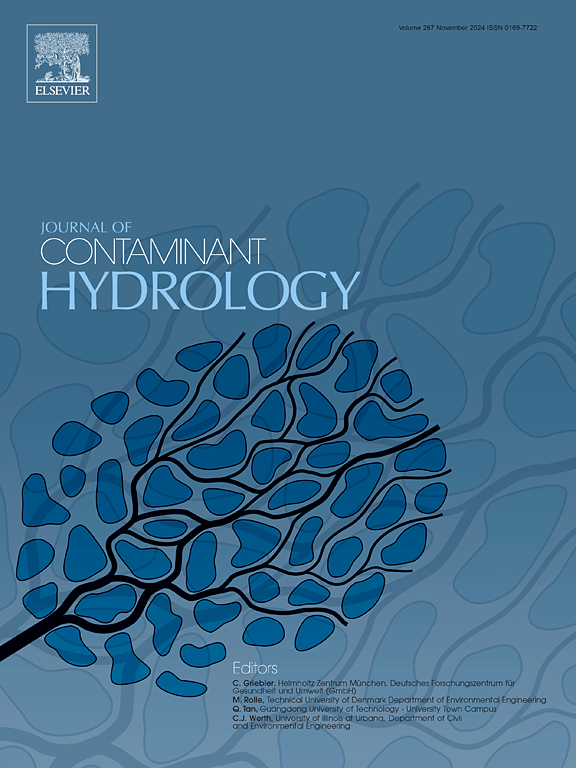Groundwater nitrate responses to extreme rainfall in alluvial–diluvial plain aquifers: Evidence from hydrogeochemistry and isotopes
IF 3.5
3区 环境科学与生态学
Q2 ENVIRONMENTAL SCIENCES
引用次数: 0
Abstract
Rainfall promotes the infiltration of surface materials into aquifers, but its role in nitrogen enrichment in the aquifers of the North China Plain remains unclear. This study collected surface water and groundwater samples after heavy rainfall and analyzed hydrogeochemical, isotopic, and nitrate properties. Results showed that groundwater nitrate concentrations were significantly higher than surface water, with levels far exceeding standards. Groundwater was primarily high-nitrate HCO₃-Ca type, controlled by carbonate and silicate dissolution. After rainfall, nitrate concentrations of groundwater increased in the northern part and decreased in the southern part, showing spatial variations. NO₃−/Cl− ratios identified agriculture, reclaimed water, and sewage as primary nitrate sources, while tritium analysis confirmed ongoing pollution from agricultural activities and domestic sewage. Industrial activities impacted surface water nitrate more significantly, while agriculture and sewage dominated groundwater pollution. Groundwater nitrate concentration changes were predominantly influenced by the unsaturated zone and soil permeability. In rapid groundwater response zone, rainfall rapidly transported surface nitrate into groundwater, increasing its concentration. In delayed groundwater response zone, limited infiltration and dilution from return flow reduced nitrate levels. This study elucidates the mechanisms governing nitrate variations after rainfall, providing scientific guidance for the protection and restoration of water quality in the North China Plain.
冲积-洪积平原含水层地下水硝酸盐对极端降雨的响应:来自水文地球化学和同位素的证据
降雨促进地表物质入渗进入含水层,但其在华北平原含水层氮富集中的作用尚不清楚。本研究采集了暴雨后的地表水和地下水样本,分析了水文地球化学、同位素和硝酸盐的性质。结果表明,地下水硝酸盐浓度明显高于地表水,且远超标准。地下水主要为高硝酸盐HCO₃-Ca型,受碳酸盐和硅酸盐溶解控制。降雨后,地下水硝酸盐浓度北部升高,南部降低,呈现空间差异。NO₃−/Cl−比值确定农业、再生水和污水是主要的硝酸盐来源,而氚分析证实了农业活动和生活污水造成的持续污染。工业活动对地表水硝酸盐的影响更大,而农业和污水污染主要是地下水污染。地下水硝酸盐浓度变化主要受非饱和带和土壤渗透性的影响。在地下水快速响应区,降雨将地表硝酸盐迅速输送到地下水中,使其浓度增加。在滞后的地下水响应区,有限的入渗和回流稀释降低了硝酸盐水平。本研究阐明了降雨后硝态氮变化的调控机制,为华北平原水质保护与恢复提供科学指导。
本文章由计算机程序翻译,如有差异,请以英文原文为准。
求助全文
约1分钟内获得全文
求助全文
来源期刊

Journal of contaminant hydrology
环境科学-地球科学综合
CiteScore
6.80
自引率
2.80%
发文量
129
审稿时长
68 days
期刊介绍:
The Journal of Contaminant Hydrology is an international journal publishing scientific articles pertaining to the contamination of subsurface water resources. Emphasis is placed on investigations of the physical, chemical, and biological processes influencing the behavior and fate of organic and inorganic contaminants in the unsaturated (vadose) and saturated (groundwater) zones, as well as at groundwater-surface water interfaces. The ecological impacts of contaminants transported both from and to aquifers are of interest. Articles on contamination of surface water only, without a link to groundwater, are out of the scope. Broad latitude is allowed in identifying contaminants of interest, and include legacy and emerging pollutants, nutrients, nanoparticles, pathogenic microorganisms (e.g., bacteria, viruses, protozoa), microplastics, and various constituents associated with energy production (e.g., methane, carbon dioxide, hydrogen sulfide).
The journal''s scope embraces a wide range of topics including: experimental investigations of contaminant sorption, diffusion, transformation, volatilization and transport in the surface and subsurface; characterization of soil and aquifer properties only as they influence contaminant behavior; development and testing of mathematical models of contaminant behaviour; innovative techniques for restoration of contaminated sites; development of new tools or techniques for monitoring the extent of soil and groundwater contamination; transformation of contaminants in the hyporheic zone; effects of contaminants traversing the hyporheic zone on surface water and groundwater ecosystems; subsurface carbon sequestration and/or turnover; and migration of fluids associated with energy production into groundwater.
 求助内容:
求助内容: 应助结果提醒方式:
应助结果提醒方式:


